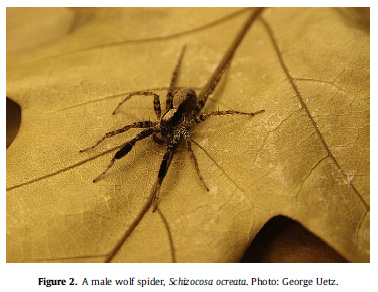Predator detection and subsequent antipredator response behaviours have been documented in many vertebrate and invertebrate animals, although the degree of specificity in predator recognition and response varies. We examined responses of actively courting adult male Schizocosa ocreata (Hentz) wolf spiders to cues indicating the presence of an avian predator, including visual, seismic (substrate vibration) and acoustic (airborne) stimuli. Spiders responded to acoustic (bird call) and seismic (simulated beak tap) stimuli with cessation of courtship and movement, but increased locomotion when presented with a visual stimulus (bird shadow). Spiders responded to experimental playback of avian acoustic stimuli with antipredator behaviour significantly more often and took longer to return to courtship than when exposed to nonthreatening stimuli. Tests of responses on different substrata to isolate sensory modes revealed that spiders perceive airborne sound from bird calls as substratum-conducted vibration. Results indicate that S. ocreata are capable of recognizing sensory cues associated with avian predators and distinguishing them from nonthreatening stimuli, suggesting that bird predation has been a selection factor in shaping behaviour of this wolf spider species.
Lohrey AK, Clark DL, Gordon SD, Uetz GW. 2009. Anti-predator responses of wolf spiders (Araneae: Lycosidae) to sensory cues representing an avian predator. Animal Behaviour. 77:813-821.
Behavior, Physiology and Biomechanics, Vibration
